Fukushima 10 years on: Learning how to communicate an ongoing disaster
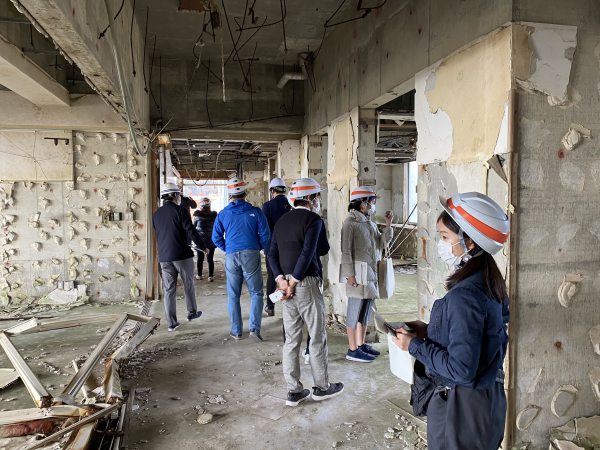
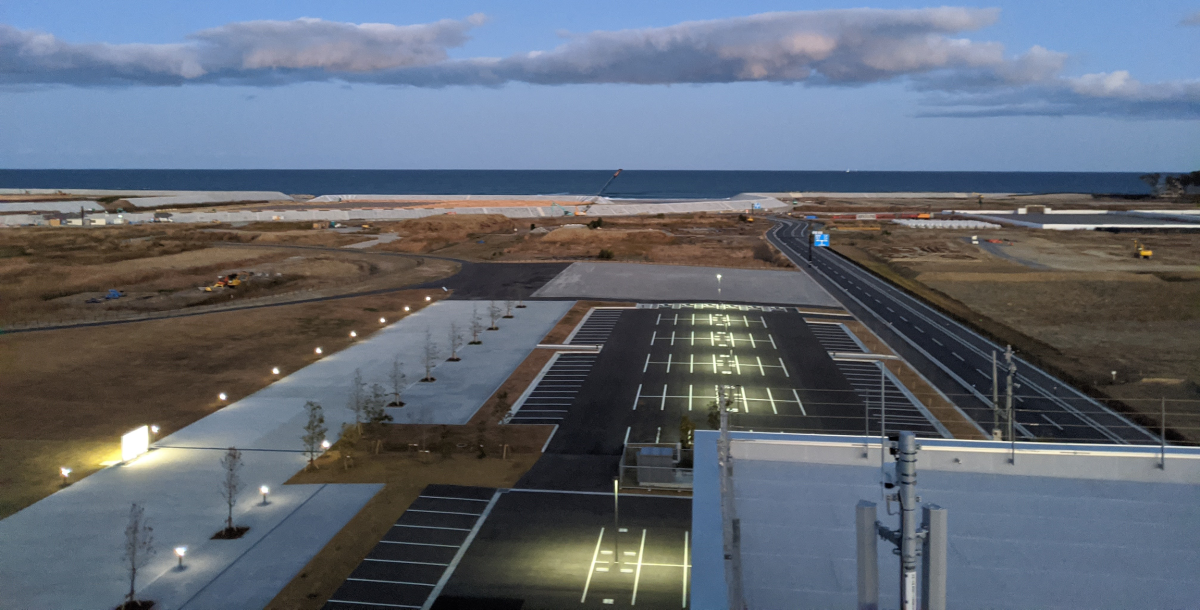
The present-day coastal area in Futaba, Fukushima Prefecture, as seen from the rooftop of the Futaba Business Incubation and Community Center on Nov. 21, 2020. A sea wall built along the shore and construction vehicles at work can be seen, but the parking lot remains empty and the area is bereft of other human activity.
What lessons can we learn and pass on a decade from the Great East Japan Earthquake when many of the issues left in its wake are still unresolved? Leading up to the 10th anniversary of the quake and tsunami that struck Japan’s Tohoku region in March 2011, a group of University of Tokyo students took a field trip to Fukushima Prefecture, which also was rocked by a nuclear accident, as part of their studies on how to communicate disaster — one that is still unfolding.
On March 11, 2011, a magnitude 9.0 earthquake struck off the Pacific coast of Japan’s northeastern region of Tohoku, and the giant tsunami that followed led to nuclear disaster at Tokyo Electric Power Company Holdings’ Fukushima Daiichi Nuclear Power Plant in Fukushima Prefecture. In the decade that followed, unlike other Tohoku areas, the prefecture has grappled with radioactive contamination and other compounding problems related to the nuclear accident, on top of the devastation suffered from the earthquake and tsunami.
Associate Professor Naoya Sekiya, who teaches at the Interfaculty Initiative in Information Studies, specializes in the social psychology and risk communication of nuclear and natural disasters.
“Even after 10 years, Fukushima still bears many problems to this day, including displaced citizens, radioactive decontamination, decommissioning of nuclear reactors, treatment of contaminated water and the harmful effects of unfounded rumors and misinformation, among other issues,” said Sekiya.
“The atomic bombings of Hiroshima and Nagasaki, or the severe mercury poisoning in the town of Minamata in Fukuoka Prefecture (whose citizens consumed contaminated seafood caught in waters polluted by industrial waste), have, over time, come to echo messages calling for peace and environmental protection, respectively. However, the lesson from Fukushima, where the devastation still lives on in the present, is not yet apparent.”
Visiting Fukushima now is critical
Sekiya stressed that visiting Fukushima now is critical for students interested in studying social problems and journalism. From Nov. 20-22, 2020, he led a three-day field trip to the neighboring towns of Futaba and Namie in Fukushima Prefecture, so students could think and learn about communicating the kind of disaster that has not been brought to closure yet.
“The nuclear disaster issue will continue to exist several decades from now,” Sekiya said. “Understanding the issues at hand on the 10th anniversary helps inform ways of conveying the lessons learned from the Fukushima nuclear accident and the Great East Japan Earthquake, and facing challenges that still remain; it will serve as the basis for understanding disaster and crisis in the future, while giving us the opportunity to revisit the atomic bombings of Hiroshima and Nagasaki in the past, or the Okinawa problem (involving the dispute over U.S. military bases and a number of other issues between the island prefecture and the Japanese and American governments).”
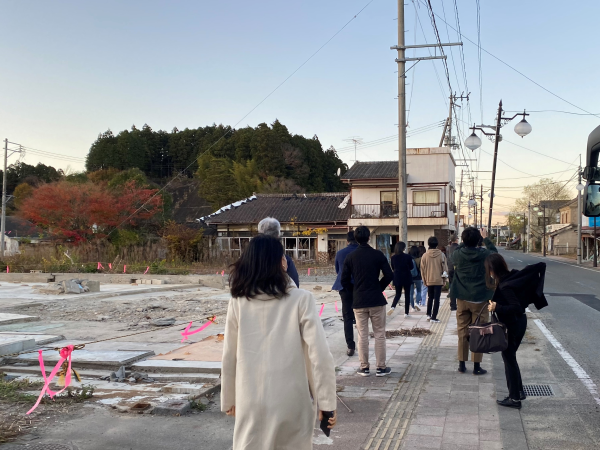
Participants tour an area near Futaba Station where restrictions on entry have been lifted. The station reopened in March 2020.
Seventeen participants, consisting of graduate students enrolled in a nuclear disaster theory course at the Graduate School of Interdisciplinary Information Studies and members of a seminar on media and journalism in the Undergraduate Research Student Program at the Interfaculty Initiative in Information Studies, took part in the field trip.
The students visited the Fukushima Daiichi nuclear plant, where they observed firsthand nuclear reactor units 1 to 4, damaged and disabled by the tsunami, and tanks containing contaminated water, deepening their understanding of the accident. They also toured the TEPCO power utility’s Decommissioning Archive Center, helping to shed light on the plant’s decommissioning project.
In addition, the group visited other landmarks, including the Great East Japan Earthquake and Nuclear Disaster Memorial Museum, which opened in September 2020 to preserve the lessons learned from the disaster, and where Sekiya serves as a senior fellow; the ruins of Ukedo Elementary School, destroyed by the tsunami; and Mount Ohira, where children and teachers from the elementary school evacuated and survived the tsunami, and where Ohirayama Cemetery is now located.
The participants also walked around Futaba Station, which reopened in March 2020 with the full resumption of services on railway operator JR East’s Joban Line, and Michinoeki Namie, a roadside rest area, which has become a symbol of recovery and serves as a gathering place for local residents.
The students also attended special lectures delivered by Project Professor Kazuhiko Amano from Fukushima University, a journalist at broadcaster TV-U Fukushima, and a resident of Namie. Through this class they were made to think about conveying lessons of disaster and communicating disaster.
The program was carried out as part of UTokyo’s Future Society Initiative project “Next Generation Risk Communication Research and Center of Excellence.” UTokyo’s Isotope Science Center helped perform COVID-19 PCR tests, which all participants were required to take due to the ongoing pandemic. They also had to self-isolate prior to the trip.
Pinning down what is so complex
The participants held an online session to report on their findings from the trip after returning from Fukushima. When a student characterized the disaster as having complexity, Sekiya responded by posing the question: “It is true that there are various issues that make the situation complex, but you have to try to pin down what is so complex, why it feels complex and the actual nature of the complexity, don’t you?”
The students reflected on the voices of the various people they encountered in Fukushima and were perplexed when trying to understand the current situation.
Sekiya points out that Fukushima’s nuclear disaster is unlike past natural disasters in that the damage left behind persists over the medium to long term. He says it has the distinct characteristic of being evaluated differently, depending on one’s position, and communication to reach a common understanding in society is especially difficult.
“There are two notable trends in viewing the nuclear disaster,” Sekiya said.
“One looks at the larger impact of the nuclear accident and radiation, such as the evacuation of wide areas and displacement of citizens from outside the designated evacuation zones; health effects, seen in the incidence of thyroid cancer and other consequences; fear and anxiety toward irradiation; or reparation. The other focuses on the recovery of Fukushima, such as regional revitalization; return of citizens to their homes; recovery of agriculture, forestry, fishing, and tourism; negative impact of misinformation and harmful rumors; and risk communication.”
He continued: “The former is tied to the larger view of the impact of the accident and radiation, while the latter is linked to considering matters on a smaller scale; thus, the trends are connected to varying degrees of anxiety about radiation; being pro- or anti-nuclear energy, or being for or against resuming operations at the nuclear plant; having a positive or negative attitude toward agricultural products grown in Fukushima, and so on.
“These sets of issues involve the damages arising from the same nuclear and radiation disaster; therefore, the issues are tightly linked to each other, and cannot be understood unless we regard them in their totality.”
Sekiya says the researchers’ job is to unveil the “why” and “how” of complexity. They study the total sum of nuclear disaster, and in their efforts to unravel the issues one by one, Sekiya emphasizes that fieldwork, which involves visiting a place and seeing it with one’s own eyes and talking to people, plays a critical role in recognizing the issues.
Sekiya explains that in the future, the young people of today without memories of the devastation will become university students. Higher education, the media and museums should consider what we can learn from the disaster and what to pass on to the next generation. He says this learning process continues, even amid a pandemic, and expressed his resolve to continue to offer a similar fieldwork program in the future and visit disaster-affected areas with students to face the issues.
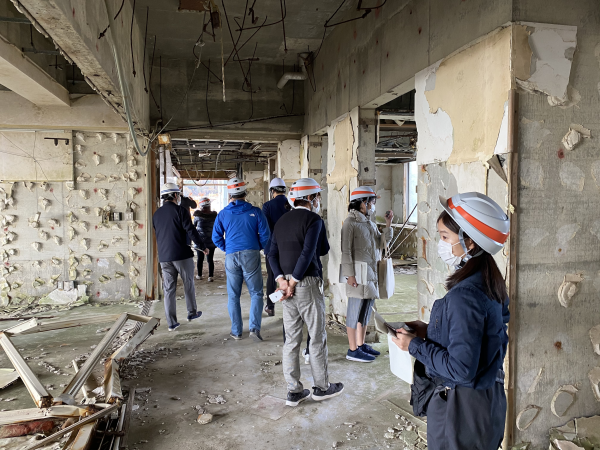
UTokyo students visit the ruins of Ukedo Elementary School in Namie, Fukushima Prefecture, on a field trip to the town. The school was devastated by the tsunami, but all its students and teachers who were there at that time evacuated to safe ground and survived.
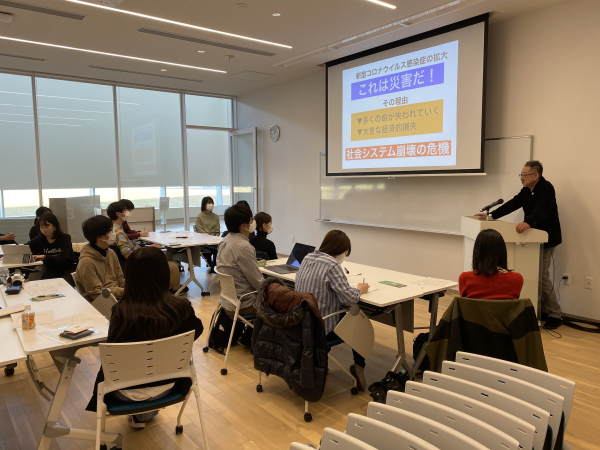
Project Professor Kazuhiko Amano of Fukushima University conducts a workshop on disaster response and operating shelters at the Great East Japan Earthquake and Nuclear Disaster Memorial Museum in Futaba, Fukushima Prefecture.
Text: Rurika Morishita (undergraduate research student at the Interfaculty Initiative in Information Studies, intern at the Public Relations Group)
Photos: Associate Professor Naoya Sekiya; Rurika Morishita (top image)






